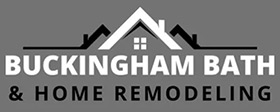The Dinner Party Realization
Picture this: You’re hosting a dinner party at your Bucks County home. The wine is flowing, the conversation is lively, and guests are moving seamlessly between the kitchen and dining area. But then, you start noticing the little things—outdated cabinets, a cramped layout, appliances that have seen better days. Someone casually mentions, “A modern kitchen would completely change this space.” And just like that, the idea of a kitchen remodel goes from a far-off dream to something you seriously want to explore.

A beautifully designed kitchen isn’t just about style—it’s about function, efficiency, and adding real value to your home. But how much should you invest to get the best balance of luxury and return on investment? Let’s break it down.
Step 1: Setting a Realistic Budget
The general rule of thumb for a kitchen remodel is to spend between 10-20% of your home’s value to maintain a strong return on investment. In Bucks County, where home values often range from $800,000 to over $2 million, that means your remodel budget could land anywhere from $80,000 to $400,000+, depending on the level of customization and quality of finishes.
- Mid-Range Remodel ($80,000-$150,000): Semi-custom cabinetry, upgraded countertops, new appliances, improved lighting, and some layout adjustments.
- High-End Remodel ($150,000-$400,000+): Luxury materials, custom cabinetry, premium appliances, reworked layouts, and high-tech smart-home integrations.
The key is setting a budget that aligns with both your home’s value and your long-term goals.
Step 2: Hidden Costs You Should Plan For
Many homeowners focus on material and labor costs, but some expenses often fly under the radar. Here are a few to factor in:
- Structural Modifications: Removing walls or expanding the footprint means added costs for engineering and permits.
- Plumbing & Electrical Updates: Older homes may require new wiring, upgraded electrical panels, or relocated plumbing to meet current codes.
- Temporary Living Arrangements: If your kitchen will be out of commission for months, you might need to budget for takeout or a temporary kitchen setup.
- Unexpected Surprises: Hidden water damage, outdated insulation, or subfloor repairs can add 10-20% in unforeseen costs.
To stay ahead of surprises, we recommend building in a 15-20% contingency fund so your remodel stays on track without unnecessary stress.
Step 3: ROI – What’s the Payoff?
A kitchen remodel isn’t just about aesthetics—it’s also a smart investment. According to Remodeling Magazine’s Cost vs. Value Report, a high-end kitchen renovation in the Mid-Atlantic region typically recoups 50-60%of its cost at resale. However, in premium neighborhoods like Newtown, Doylestown, or Solebury, buyers expect high-end kitchens, often leading to stronger returns.
Beyond resale value, there’s also the lifestyle ROI—the improved functionality, enjoyment, and ease of entertaining that a well-designed kitchen brings. Many homeowners say their new kitchen completely transforms how they cook, host, and spend time with family.
Step 4: Designing a Kitchen That Reflects Your Lifestyle
Your kitchen should be built around your needs—whether you love to cook, entertain, or just want a beautiful, easy-to-use space. Consider:
- Custom vs. Semi-Custom Cabinetry: Custom cabinets maximize every inch, but semi-custom options balance style and budget.
- Appliance Selection: High-end brands like Wolf, Sub-Zero, and Miele offer professional performance and durability.
- Smart Technology: Touchless faucets, built-in coffee systems, and Wi-Fi-enabled ovens make cooking easier than ever.
- Layout & Flow: Optimized counter space, smart storage solutions, and comfortable seating make your kitchen as practical as it is stunning.
At Buckingham Bath & Home Remodeling, we specialize in designing kitchens that seamlessly blend luxury, function, and timeless appeal. Whether you’re updating an outdated space or undergoing a full-scale redesign, every detail should align with your vision.
Step 5: Understanding the Remodeling Timeline
Knowing what to expect helps you plan realistically. Here’s a general timeline for a full kitchen remodel:
- Design & Planning (1-3 months): Finalizing layout, materials, and appliances.
- Permitting & Ordering (1-2 months): Ensuring compliance with local codes and sourcing custom elements.
- Demolition & Construction (3-6 months): Structural changes, installations, and finishing touches.
- Final Inspections & Move-In (1-2 weeks): Ensuring everything meets the highest standards before you start enjoying your new space.
The Bottom Line: Making the Right Investment
A kitchen remodel is a big financial commitment, but with thoughtful planning and expert craftsmanship, it’s one of the best investments you can make. The key is to align your budget with your priorities—whether maximizing resale value or creating a space tailored to your lifestyle.
So, if you could design your dream kitchen, what’s the one feature you wouldn’t compromise on?
